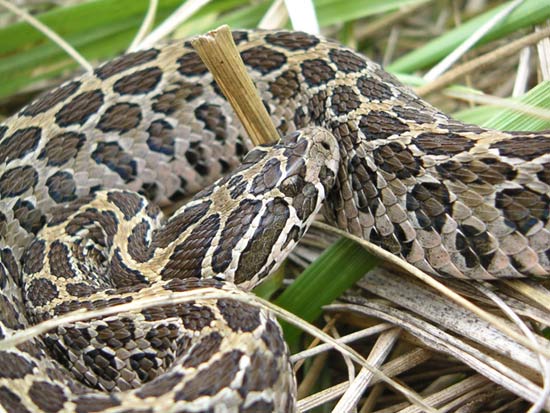Cannibalistic Rattlesnakes Eat Dead Offspring

Every mom knows that pregnancy and birth really sap your energy. To get some back, many rattlesnake mothers will eat some of their non-surviving offspring, a new study finds.
This postpartum cannibalism helps the mother regain strength for her next reproductive effort, researchers report.
A lack of information on cannibalism in rattlesnakes prompted a group of Spanish, American and Mexican researchers to begin a study in 2004 that monitored cannibalistic behavior in 190 female pitvipers (Crotalus polystictus) found in central Mexico, where the species is endemic. The snakes had a combined total of 239 clutches of eggs over the study period.
The researchers found that on average, the mother snakes ate about 11 percent of their postpartum mass — particularly eggs and dead offspring — to regain energy.
"A cannibal rattlesnake female can recover lost energy for reproduction without having to hunt for food, a dangerous activity that requires time and expends a great deal of energy," said Estrella Mociño and Kirk Setser, lead authors of the study and researchers at the University of Granada in Spain.
A wide variety of animals have been found to eat their offspring, including polar bears, burying beetles, hamsters, wolf spiders and a range of fish species. Scientists have looked for reasons why species might devour their genetic progeny.
The new study, detailed in the January 2009 issue of the journal Animal Behaviour, shows that cannibalism in this species is an evolutionary result of the snake's feeding behavior, since its prey is dead for some time before being eaten by the snake.
Get the world’s most fascinating discoveries delivered straight to your inbox.
"Viperids in general are prepared to eat carrion, and for this reason it is not so strange that they consume the non-viable sections of their clutches after going through the great energy expenditure caused by reproduction," Mociño said.
Mociño and his colleagues found that four factors influenced whether the mothers practiced cannibalism and how much they ate:
- the day of the birth (females that give birth at the end of July are more likely to be cannibals, since they have less time to feed and prepare themselves to reproduce again);
- the proportion of dead babies per clutch;
- the level of maternal investment (the larger the brood, the greater the chance that it will contain non-viable elements, which she will eat);
- and stress caused by being in captivity (the researchers maintained the females in captivity for an average of 21 days).
Of all the females, 68 percent consumed part or all of their dead offspring, and 83 percent of these ate them all, and waited little time to do so (around 16 hours), although some ate them "immediately after giving birth," Mociño said. The rest (40 percent) of the females didn't eat any of their dead offspring.
The researchers said this cannibalism is not the same as parricide or infanticide since they're not eating live offspring, even though they look very similar to dead ones for the first two hours after emerging from their membranes. During the study, only one female ate live babies.
Crotalus polystictus is a "threatened species," according to Mexican officials. Limited habitat, as well as agricultural and urban expansion are the main threats to the snake. The research was partially funded by T&E, Inc. and The Explorers Club.
{{ video="210607rattlesnakes" title="Snake Trackers" caption="How researchers are tracking and observing the behaviors of timber rattlesnakes and copperheads." }}
- Video - Snake Trackers
- 10 Amazing Things You Didn't Know About Animals
- Snake Images, News and Information



